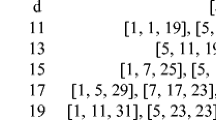Abstract
Itis conjectured that there exist at most 2k equidistantpoints in the k-dimensional rectilinear space.This conjecture has been verified for k ≤ 3; we show here its validity in dimension k = 4. We alsodiscuss a number of related questions. For instance, what isthe maximum number of equidistant points lying in the hyperplane:\(\sum\nolimits_{i = 1}^k {x_i } = 0?\) If this number would be equal to k, then the above conjecture would follow. Weshow, however, that this number is ≥ k + 1 for k ≥ 4.
Similar content being viewed by others
References
H.-J. Bandelt, V. Chepoi and M. Laurent, Embedding into rectilinear spaces, Discrete and Computational Geometry, Vol. 19 (1998) pp. 595–604.
L. M. Blumenthal, Theory and Applications of Distance Geometry, Clarendon Press, Oxford (1953).
L. Danzer and B. Grünbaum, Ñber zwei Probleme bezüglich knovexer Körper von P. Erdös und von V. L. Klee, Mathematische Zeitschrift, Vol. 79 (1962) pp. 95–99.
L. Danzer, B. Grünbaum and V. Klee, Helly' theorem and its relatives, Proceedings of Symposia in Pure Mathematics, American Mathematical Society, Providence, Rhodes Island, VII (1963) pp. 101–181.
N. G. de Bruijn and P. Erdös, On a combinatorial problem, Indagationes Mathematicae, Vol. 10 (1948) pp. 421–423.
M. Deza and M. Laurent, Geometry of cuts and metrics, Algorithms and Combinatorics, Springer Verlag, Berlin, 15 (1997).
B. Fichet, Dimensionality problems in L1-norm representations, Classification and Dissimilarity Analysis, Lecture Notes in Statistics, Springer-Verlag, Berlin, 93 (1994) pp. 201–224.
T. Fleiner, Covering a symmetric poset by symmetric chains, Combinatorica, Vol. 17 (1997) pp. 339–344.
Z. Füredi, J. C. Lagarias, and F. Morgan, Singularities of minimal surfaces and networks and related extremal problems in Minkowski space, Discrete and Computational Geometry (J. E. Goodman et al.,eds.) Vol. 6 of DIMACS Series in Discrete Mathematics and Theoretical Computer Science (1991) pp. 95–109.
H. Groemer, Abschätzungen für die Anzahl der knovexen Körper die einen konvexen Körper berühren, Monatshefte für Mathematik, Vol. 65 (1961) pp. 74–81.
B. Grünbaum, On a conjecture of H. Hadwiger, Pacific Journal of Mathematics, Vol. 11 (1961) pp. 215–219.
R. K. Guy and R. B. Kusner, An olla podrida of open problems, often oddly posed, American Mathematical Monthly, Vol. 90 (1983) pp. 196–199.
F. Hadlock and F. Hoffman, Manhatten trees, Utilitas Mathematica, Vol. 13 (1978) pp. 55–67.
H. Hadwiger, Ueber Treffanzahlen bei translationsgleichen Eikörpern, Archiv der Mathematik, Vol. 8 (1957) pp. 212–213.
G. R. Lawlor and F. Morgan, Paired calibrations applied to soap films, immiscible fluids, and surfaces and networks minimizing other norms, Pacific Journal of Mathematics, Vol. 166 (1994) pp. 55–82.
P. W. H. Lemmens and J. J. Seidel, Equiangular sets of lines, Journal of Algebra, Vol. 24 (1973) pp. 494–512.
F. Morgan, Minimal surfaces, crystals, networks, and ungraduate research, Mathematical Intelligencer, Vol. 14 (1992) pp. 37–44.
C. M. Petty, Equilateral sets in Minkowski spaces, Proceedings of the American Mathematical Society, Vol. 29 (1971), pp. 369–374.
K. J. Swanepoel, Extremal problems in Minkowski space related to minimal networks, Proceedings of the American Mathematical Society, Vol. 124 (1996) pp. 2513–2518.
K. J. Swanepoel, Cardinalities of k-distance sets in Minkowki spaces, Technical report UPWT 97/4, University of Pretoria (1997).
H. P. F. Swinnerton-Dyer, Extremal lattices of convex bodies, Proceedings of the Cambridge Philosophical Society, Vol. 49 (1953) pp. 161–162.
I. Talata, Exponential lower bound for the translative kissing numbers of d-dimensional convex bodies, Discrete and Computational Geometry, Vol. 19 (1998) pp. 447–455.
I. Talata, The translative kissing number of tetrahedra is 18, Discrete and Computational Geometry, Vol. 22 (1999) pp. 231–248.
A. C. Thompson, Minkowski Geometry, Encyclopedia of Mathematics and its Applications, Cambridge University Press, 63 (1996).
J. H. van Lint and J. J. Seidel, Equilateral point sets in elliptic geometry, Indagationes Mathematicae, Vol. 28 (1966) pp. 335–348.
Author information
Authors and Affiliations
Rights and permissions
About this article
Cite this article
Koolen, J., Laurent, M. & Schrijver, A. Equilateral Dimension of the Rectilinear Space. Designs, Codes and Cryptography 21, 149–164 (2000). https://doi.org/10.1023/A:1008391712305
Issue Date:
DOI: https://doi.org/10.1023/A:1008391712305




